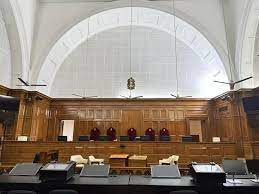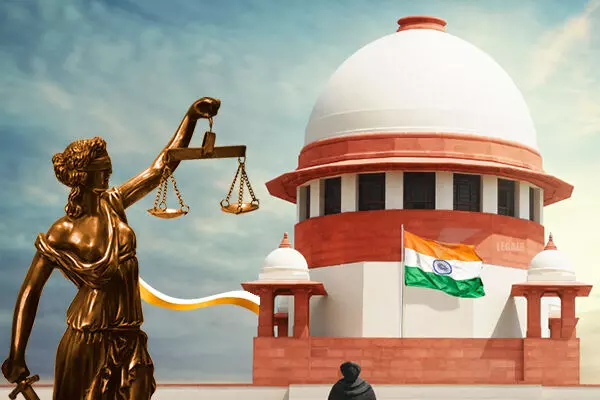CJI Ensures Uniformity in SC Judges’ Chairs’ Height, Displaying Leadership Amidst Global Scrutiny

CJI Ensures Uniformity in SC Judges’ Chairs’ Height, Displaying Leadership Amidst Global Scrutiny
In a resolute display of leadership, Chief Justice of India (CJI) takes proactive steps to address a seemingly inconspicuous yet symbolically significant matter. The height of Supreme Court judges’ chairs, a subject of scrutiny and discussion following a recent UK event, has been harmonized to evoke a sense of unity and equality within the judiciary. This unanticipated move not only underscores the CJI’s commitment to upholding the principles of fairness and impartiality but also exemplifies the influence of seemingly minor decisions in portraying an institution’s image.
The incident that prompted this unprecedented action occurred during an international event in the United Kingdom. A casual observation made by a participant raised questions about the varying heights of the chairs occupied by the justices in the highest court of the land. This seemingly trivial detail triggered an unexpected dialogue, causing ripples of discourse across various legal circles.
In response, Chief Justice of India, recognized for his astute awareness of the judiciary’s role in society, seized the opportunity to make a subtle yet impactful change. Addressing the press, the CJI remarked, “The judiciary is a symbol of impartiality and unity. While the varying chair heights were never an overt issue, it’s imperative that we convey our dedication to equality even in the minutest aspects.”
The decision to standardize the height of the judges’ chairs, although seemingly straightforward, resonates on multiple levels. At its core, it exemplifies the judiciary’s commitment to ensuring that even the most unassuming elements are free from disparity. A symbol of equality, the uniform chair height serves as a visual representation of the court’s mission to provide fair and consistent justice for all citizens.

The ripple effect of the CJI’s directive stretches beyond the confines of the courtroom. It demonstrates a remarkable instance of an institution’s responsiveness to public perception. Such seemingly minor details, when overlooked, can inadvertently contribute to a perception of hierarchy and privilege. By addressing this concern head-on, the CJI reinforces the idea that the judiciary stands on an equal footing with the citizens it serves.
The move also invites introspection within the broader legal community. The legal fraternity has historically been associated with complex jargon and intricate protocols. However, this gesture signals a willingness to adapt to contemporary sensibilities. It underscores that modern justice should not only be fair but also accessible and comprehensible.
Experts laud this decision as a testament to the CJI’s ability to lead with a nuanced understanding of the institution’s role in a rapidly evolving world. Legal scholar Professor Maya Singh opines, “It’s not just about chairs, it’s about adapting to the changing dynamics of society. The CJI has displayed a keen awareness of symbolism, proving that leadership transcends the courtroom.”
The story also resonates internationally, highlighting India’s dedication to judicial parity and the pursuit of justice for all. During a time when even the minutest actions of public figures undergo intense scrutiny, this unanticipated step sends a powerful message to the global community. It demonstrates a commitment to equality that resonates across borders and cultures.
In conclusion, what may appear to be a simple adjustment in the height of judges’ chairs reveals a profound commitment to equality and impartiality within the judiciary. Chief Justice of India’s decision to standardize the chair heights serves as a lesson in leadership, demonstrating how even the smallest details can carry significant symbolism. This unexpected move underscores the judiciary’s role as a beacon of fairness, unity, and accessibility, transcending national boundaries and resonating with citizens and legal experts alike. As society evolves, so must its institutions, and the judiciary’s responsiveness to such matters reaffirms its vitality in shaping a just and equitable world.

Beyond its symbolic resonance, the harmonization of chair heights symbolizes the judiciary’s commitment to maintaining a level playing field within its ranks. By addressing a seemingly innocuous detail, the CJI underscores the importance of uniformity and cohesion among the justices. This move acknowledges that even minor differences in physical arrangements can inadvertently impact perceptions of hierarchy and authority within the court.
The decision also reflects the broader trend of institutions adapting to contemporary expectations. In an era marked by transparency and accountability, even seemingly minor decisions have the potential to shape public perception. By taking swift action in response to a casual observation, the CJI demonstrates an understanding of the need to remain in touch with the evolving expectations of society.
Moreover, the harmonization of chair heights serves as a microcosm of the judiciary’s commitment to accessibility. While the legal field has long been characterized by its complex terminology and procedures, this gesture signifies a desire to bridge the gap between the legal realm and the public it serves. By addressing a detail as mundane as chair heights, the CJI highlights the need for clarity and comprehensibility, making justice more accessible to a diverse array of citizens.

In an era where symbols carry immense weight, the CJI’s decision to standardize chair heights becomes a point of reference for institutional leadership. It underscores the potential of seemingly insignificant actions to speak volumes about an institution’s values and priorities. The harmonization of chair heights serves as a beacon of equality, accessibility, and unity within the judiciary, setting an example for other institutions to follow and reaffirming the court’s role as a bulwark of fairness in a complex world.




